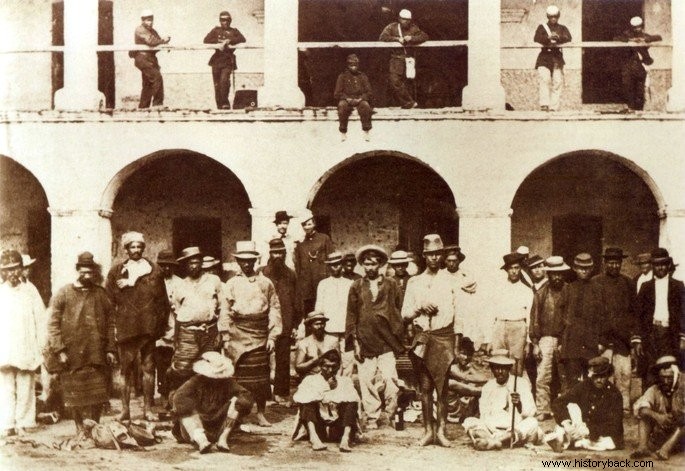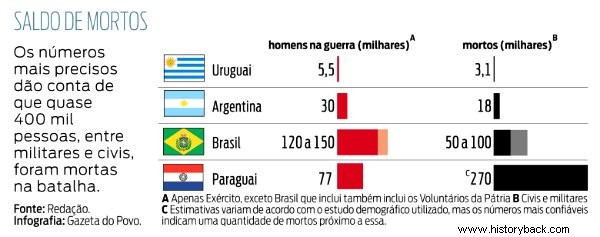TheParaguay War was an armed conflict that took place between the years 1864 and 1870.
The countries involved were Brazil, Argentina and Uruguay, which formed the Triple Alliance to fight Paraguay.
The combat took place because Paraguay intended to annex territories from Brazil and Argentina. Likewise, control over the La Plata Basin was at stake.
The Paraguayan War would end with the victory of the Triple Alliance.
Causes of the Paraguayan War
Paraguayan expansion
The Paraguayan War took place due to the desire of dictator Solano López to create the "Great Paraguay". For this, he intended to annex areas of Brazil and Argentina that would allow him to have an outlet to the sea.
Navigation in the La Plata Basin
For its part, Brazil asked for free navigation on the rivers that cut through Paraguay, as it was the only way to reach Cuiabá (MT).
Situation in Uruguay
Likewise, the internal situation of Uruguay has always been of interest to the three countries, as it is located in a strategic point, on the banks of the Rio de la Plata.
Brazil and Argentina supported the colorados , while Solano López was a supporter of his opponents, the Whites .
Paraguay before the War
Before the war, Paraguay was an agrarian country, but it started to develop the war industry, due to the expansion plans of Solano López.
Since its independence in 1811, Paraguay has sought to isolate itself from regional conflicts such as the Cisplatine War in 1825-1827.
Upon assuming the presidency in 1862, dictator Solano López (1827-1870) continued the nationalist economic policy of his predecessors. However, he went on to support groups in Argentina and Uruguay that coincided with his interests.
One of these groups were the blancos , in Uruguay, that could allow the use of the port of Montevideo by the Paraguayans. In Argentina, Solano López allied with the Federalists, enemies of then President Bartolomeu Mitre.
The Situation of Uruguay and the War in Paraguay
When Uruguay gained its independence in 1825, the country was divided between two political factions:blancos (white) and colored (red). Brazil and Argentina, in order to maintain their influence, supported the Colorados .
In 1864, the coalition between the two parties broke up and the Colorados plotted to remove the leader of this alliance, Bernardo Berro, from power.
Civil war begins in Uruguay. The colored ask for help from Brazil, which sends troops to Uruguay. They also have the help of Bartolomeu Miter, president of Argentina. For their part, the blancos received support from Solano López and Miter's enemies.
Due to their superiority in warfare, the Colorados managed to defeat the Whites in 1864. However, Solano López crosses Argentine territory - without authorization from President Miter - to attack the Brazilians.
This fact would be the trigger for the Paraguayan War.
Start of the Paraguayan War
In November 1864, Solano López ordered the arrest of the Brazilian ship Marquês de Olinda, on the Paraguai river, which was heading towards Cuiabá (MT).
Despite being a merchant ship, Solano López suspected that there were weapons hidden in the holds. Soon after, he attacked the city of Dourados (MT).
The following year, Paraguayan troops crossed Argentine territory - without authorization from the Argentine authorities - and conquered Rio Grande do Sul. Months later, the territory would be retaken in the Battle of Riachuelo.
Treaty of the Triple Alliance
In view of this, the Brazilian government proposes to its neighbors, Argentina and Uruguay, a mutual aid treaty against Solano López.
On May 1, 1865, the Treaty of the Triple Alliance between the three countries involved in the war was formalized. Allied troops would be under the command of Argentine President Bartolomeu Miter.
Main Battles of the Paraguayan War
Battle of Tuyuti
On May 24, 1866, the Battle of Tuiuti was fought, which ended with a toll of 13,000 dead. Paraguayan forces attacked the allies in swampy terrain and initially gained the upper hand. Delays and poor distribution of weapons, however, favored the Triple Alliance's victory.
Despite being victorious in this battle, General Osório left the command of the Brazilian forces and was replaced by the Marquis of Caxias (future Duque de Caxias).
The Battle of Tuiuti is considered the largest pitched battle in South America.
Withdrawal from the Lagoon
In 1867, Brazilian troops tried to liberate part of Mato Grosso, which was in Paraguayan hands.
A column left Minas Gerais and headed towards Mato Grosso. Suffering from illness and lack of supplies, the Brazilians were defeated by López's troops, in the episode known as the Laguna Retreat (MS).
Battle of Humaitá
Caxias was considered one of the most experienced soldiers in the Brazilian Army. He was called upon by the imperial government in order to organize and strategize to achieve victory.
In this way he was responsible for a series of military triumphs that aimed to conquer the fort of Humaitá, captured on February 19, 1868. Thus, the allied troops were able to advance into Paraguayan territory.
December
The December consists of three battles fought in Itororó, Avaí, Angostura and Lomas Valentinas, in December 1868.
Then, the allied troops march on the city of Asunción, winning the conflict.
End of the Paraguayan War

After conquering Assunção, in January 1869, Caxias left the command of the war to D. Pedro II's son-in-law, Prince Luís Gastão, Count d'Eu.
The new commander had express orders from the emperor to capture Solano López dead or alive. Thus, faced with the non-surrender of the Paraguayan army, the Count d'Eu pursued Solano López and his soldiers.
The fight only ended with the disappearance of the Paraguayan dictator in Cerro Corá, on March 1, 1870, who was killed for refusing to surrender. It was the end of the war between Brazil and Paraguay.
Consequences of the War in Paraguay
The war left great damage both in Brazil and in Paraguay, which was razed to the ground. Approximately 80% of the male population was decimated and what remained were old people, children and war maimed.
The confrontation left the few existing industries destroyed, the land uncultivated and the population basically started to live on subsistence farming.
In addition, it lost part of the territory to Argentina and Brazil, and contracted a war debt with the countries of the Triple Alliance. Uruguay forgave her in 1885, Argentina in 1942 and Brazil in 1943.
With regard to Brazil, the dispute cost thousands of lives and greatly affected the economy, making it necessary to take out several loans to maintain financial balance.
On the other hand, at the end of the war, Brazil achieved freedom of navigation in the La Plata Basin and had a victorious and modernized army.
Argentina secured territories that were previously contested by Solano López, such as the province of Corrientes and the Chaco region.
England did not participate directly in the conflict, but was the only country to profit from it. The country expanded its markets in America, lent money to the reconstruction of Paraguay and to Brazil, which increased its debt.

Infographic on the death toll in the Paraguayan War
Fun facts about the Paraguayan War
- At the end of the war, Solano López ordered children over the age of 12 to participate in battles wearing false beards. Thus, most were murdered by the Brazilian army.
- In order to increase the number of soldiers, the Brazilian government instituted the “Voluntários da Pátria” in 1865. Free men were promised plots of land, money, and pensions for widows. Slaves were offered freedom when they returned.
- The Paraguayan Army built a cannon from the casting of bells from several churches in Asunción, known as the "Christian Cannon" and seized by the Brazilian Army during the conflict. It is currently located at the National Historical Museum in Rio de Janeiro. In 2014, Solano López's great-grandson asked the Brazilian government to return him.
There are more texts on this subject:
- Paraguay Basin
- Paraguay
- Second Reign
- History Questions in Enem
